Highlights.
The tower views, the raft and the night tour.
We
quietly started the day as 2 people were still appreciating the chance to catch
up on sleep while the 3rd blogged and planned.
Cesky
Krumlov had appeared as an interesting addition to our time in the Czech
Republic when I was planning our trip. It was a place I had not heard of before
then, but I did later find out that both Julie and Paul Sommerville and Shelly
D’Arcy had also spent time in the area and in their words, adored it.
Český Krumlov, in Bohemia’s deep south, is one of the most
picturesque towns in Europe. It’s a little like Prague in miniature, a Unesco
World Heritage Site, with a stunning castle above the Vltava River, an old town
square, and Renaissance and Baroque architecture. The site that said this also
mentioned the hordes of tourists, but then we are tourists.
The derivation of the town’s name is believed to be from ‘krumbe
ouwe’ meaning crooked meadow and ‘Cesky’ for Czeck. The centre is built on a horseshoe
bend in the Vltava River so the suggested derivation of the name makes sense.
The castle was erected from 1240 onwards by a noble family.
Being at the ford of a trade route, a town grew up at the foot of the castle and
was soon known as Krumlov. The castle as it is now is the third largest in Europe
and 2nd only to Prague in the Czech Republic.
We packed up picnic food and headed to the main area mid-morning.
Our first stop was to buy earrings that we had seen on special last night.
Then
we went to the castle to walk up the tower. We had looked at the other items
offered by the local tourist card but this was the only one we were all keen to
do. We stopped and saw a bear in the moat. This has been a tradition in the
castle for many years.
The tower was built with the only access being through a window
accessed by a drawbridge on the first floor. There is now a door at the bottom
with wide steps up to the first floor, but the rest is the original steps. This
makes the walk up both steep and narrow, with low beams in a couple of places where
you had to watch your head. Passing was either interesting or impossible so we
were lucky that the tower was not busy. I admit I did not look forward to the walk
down, but It actually proved to be easier than the way up.
The views from the 5th level were worth the walk.
This level is open, with panoramic views of the whole area. With three of us
with phones we have a lot of photos from here. Katherine started to talk to a
couple from Sydney who are here for 4 days. He was an architect and artist and
this place is ideal for him. As we went back down he was already sketching a
view. They gave us advice about Prague, as they had just left there.
We headed through the castle towards the gardens for our picnic.
They were quiet and we had no problem finding 2 benches to act as a table and
seat. It was very pleasant to sit and look at English flowers while we ate,
although it did seem a bit odd to be in a castle garden with cottage-like
flowers.
We later found this is known as the English garden and the next door
one, which we walked through on our way back, has a French style.
From the castle we had seen a lot of the kayakers and rafters we
had also seen the previous day. I suggested the others might like to go and I
would hold their gear. They suggested we should get a raft and all go. We all
agreed it was not urgent and we should look at more of the town and see if we
could find the company on the way. The historic town is not that big, but it
has enough side roads and bridges to give lots of possible routes. We were also
looking at menus to find possibilities for tonight’s meal.
We opted out of visiting other museums today although there were
a range, including a marionette museum, a museum of mirrors, one centred on a
famous local artist and a regional museum (which was the most tempting for me).
We found one of the rafting companies with a woman who spoke
excellent English and booked a raft for 3pm. The trip was up to an hour with a
van ride back to base. There were other longer options for not much more, but
we were all happy with a trip that would take us under 6 of the town bridges
and by the castle. I was my usual nervous self re getting into things on water,
but was fine. We all agreed you would have to work very hard to get the raft to
tip at all and then Katherine touched the river bottom a few times with the
paddle so it was clearly shallow.
I was officially captain, navigator, bridge counter and photo taker
(‘deck cargo’ - JB).
Most of the river was so gentle that Katherine took her
own photos as well. The rest of the gear was in a waterproof bucket but would
have been fine in the bottom of the boat. With 2 paddling and the current we
did get to the end much earlier than we needed to, something we were all quite comfortable
about as the paddlers were not yet tired but did feel they had had a workout.
It probably took almost as long for the boat to be loaded on the van and for us
all to be driven back to the start.
We had spotted a place selling a spiral of pastry, cooked on the
stall, and Katherine was keen to try. She opted for plain (ie covered in sugar
but not with chocolate inside) and ate it on the way back.
After a break, she and I went for a walk to a nearby chapel, for
both the views and a cache. The cache proved to be a very complicated one that
I soon gave up on, but we did enjoy the views. The only hard part was going
down the street we are on to then going across and up one that is parallel to
our road. That part is steep and added a few minutes to the walk.
We did
consider being cheeky and cutting through a spare section, but didn’t.
When we went back into the town area, the place we had pencilled
in for a meal had no spare tables. Luckily someone was leaving from the next
one so we had a table by the river. We managed to find food that included
vegetables, something we have been lacking, and it was cheaper than our first
place. This was partly because we discovered it did not accept credit cards, so
it was good we had cash on hand. We also saw lots of fish in the river and realised
for the first time, how full of fish the river was. John fed the ducks with
some of the bread that came with his meal.
John walked back while Katherine and I found the free night walking
tour host. Katherine has done a lot of these. This was my first free one,
although I also enjoy walking tours and this town is perfect for them. The tour
had only 5 people on it at the start, 4 from NZ and 1 from Australia. To be fair,
one of the NZ people had come from the Netherlands not that long ago given her
accent.
At the first stop we were joined
by a man from India so there were seven of us. Our guide was John (or Hans) and
had been an apple picker in Motueka a number of years ago.
At the this stop we admired views, heard about the history of
the town, and also had the apartments from the Communist years pointed out to
us. They were so obvious now but had not been before, even though we had been
to this viewpoint before.
The town had been owned by various families over the years. The
Rosenburg family had been given the town by the King…as royalty did. They built
the upper part of the castle and promoted trade and crafts within the town
walls, however, eventually they overextended themselves and ran out of money so
sold the town to the Hasburgs. It then passed into the hands of the House of
Schwarzenberg. The number of German residents rose considerably in their time. After World
War II the town's longstanding German-speaking population were
sent to Germany and the town was returned to Czechoslovakia. During the
Communist era the historic part was neglected which was a double edge sword.
Nothing was repaired but nothing was removed. Most of the historic area has now
been restored since the communist control was removed in 1989.
The
next spot was at the church, St Vitus, that we had walked past a few times and
not bothered to go in. Here Hans used a small projector to show us what the
inside of the church looked like. It was Gothic, and similar to others we have
seen, so be didn’t feel the need to go back for this.
Possibly the next stop was of most interest to us. Hans talked
about the importance of 8 in recent Cesky Krumlov history and showed us some
photos. The one I most remember was from 1938 and showed an area full of people
and Adolf Hitler addressing them. It took a moment to register that the square
they were in was the square we were in. The mainly German townspeople welcomed
him with open arms as he was offering food and jobs. All the other photos also
were of events in this main square. The liberation by the Americans, the
communist takeover, the tanks to squash the more liberal authorities and then
the Velvet revolution when the Czech Republic became a democracy.
We looked at the coats of arms on the town hall and heard their
history. The Roseburg family are represented by a five petal rose, the Schwarzenberg’s
by a raven pecking at a skull (Hans did say they were odd) and there was a lion
which had replaced the original bear as a symbol of strength.
At our stop at the Bridge we heard of the flood of 2003 and were
shown the height of the water.
There is a statue of a saint on the bridge to
protect the town but Hans said he must had been off duty that day. We also
stopped to see a former church that is now apartments. Hans said that only 15%
of Czechs are now religious, they are the biggest beer drinkers in the world, but the Czech Republic has a very low level
of crime.
We finished the tour with a walk through part of the castle
area. It was interesting to see it by night and to hear more of the history.
The bear was inactive in the moat and we were sad to hear she is there by herself.
The castle is to get 2 bears from Serbia at some time in the future but even
that does not seem enough. We heard the story of the drunk soldier who decided
go in and fight the bears that were there in the communist era. The soldier
lost an arm, 2 bears were shot and one was eaten by the guards. Hans said a lot
of different stories went around about the incident as people were reluctant to
believe official stories at that time.
We went through part of the castle and saw the fake windows that
had been drawn in over time. The Schwarzenberg family had used frescos to make
the effect of stone blocks many years ago for cheapness. Other areas had been
renovated since the town became a UNESCO world heritage area. He recommended
the tower and visiting the Baroque Theatre which you do need to book for but is
one of the two remaining in the world, the other being in Stockholm. It did
sound very interesting, but not enough to change tomorrow’s plans. The other
theatre here is more controversial. There is a theatre with a revolving
auditorium that has grown from seating 60 to seating 600 and is booked out
months in advance. It is controversial as UNESCO are keen that it be removed.
Hans said there are a couple of options to appease UNESCO and keep the theatre,
both of which cost millions of US dollars.
Katherine and I then walked back and were home with John by
11pm, all ready for bed.

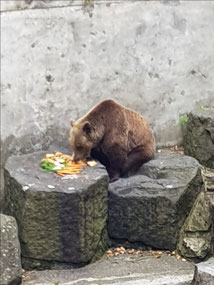
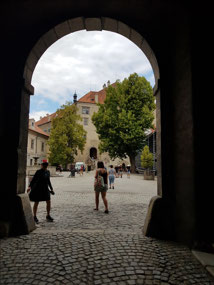
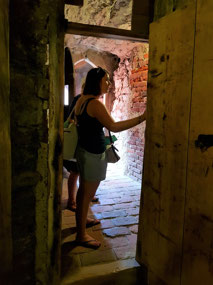
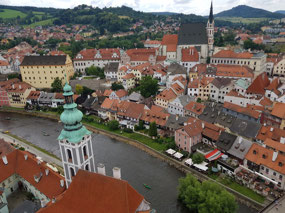
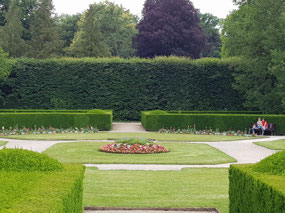
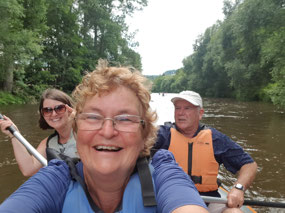
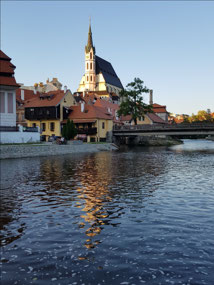
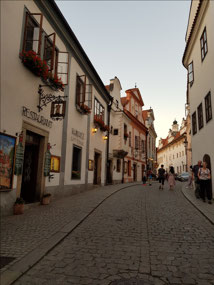








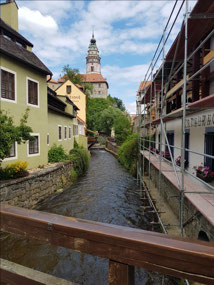
2025-05-22